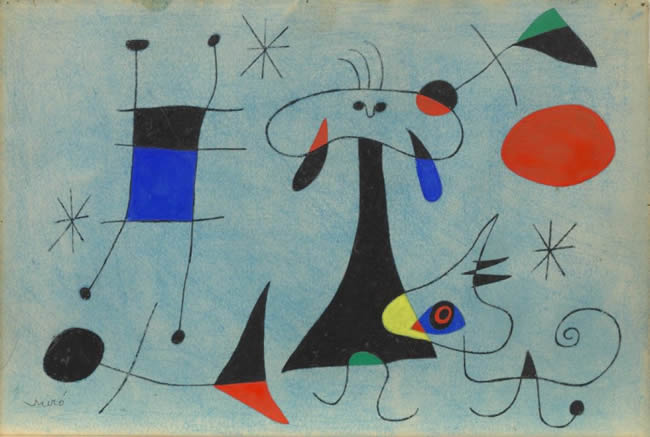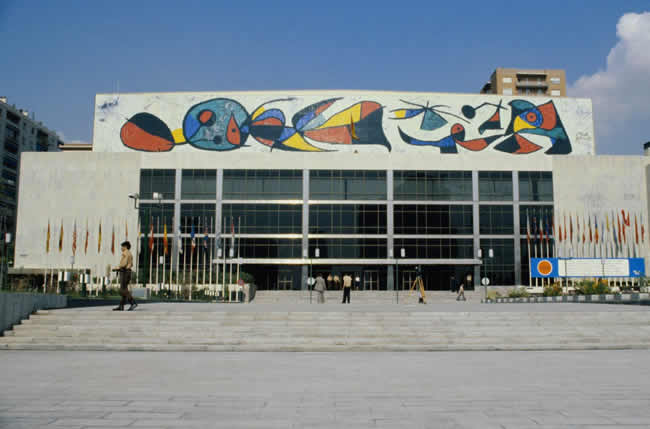
Joan Miró I Ferrà (April 20, 1893 - December 25, 1983) was one of the most celebrated artists of the 20th century. He was a leading light of the Surrealist Movement and later developed a highly recognizable idiosyncratic style. His work never became entirely abstract, but his images were frequently an altered depiction of reality. Late in his career, Miró earned acclaim for a series of public commissions that included monumental sculptures and murals.

Growing up in Barcelona, Spain, Joan Miró was the son of a goldsmith and watchmaker. Miró's parents insisted that he attend a commercial college. After working for two years as a clerk, he had a mental and physical breakdown. His parents took him to an estate at Montroig, Spain for recovery. The Catalonia landscape around Montroig became very influential in Miró's art.
Joan Miró's parents allowed him to attend a Barcelona art school after he recovered. There, he studied with Francisco Gali, who encouraged him to touch the objects he would draw and paint. The experience gave him a more powerful feeling for the spatial nature of his subjects.
The Fauvists and Cubists influenced Miró's early work. His painting Portrait of Vincent Nubiola shows the influence of both. Nubiola was a professor of agriculture at the School of Fine Arts in Barcelona, Spain. The painting was owned for a time by Pablo Picasso. Miró had a solo exhibition in Barcelona in 1918, and a few years later settled in France where he had his first Parisian exhibition in 1921.

In 1924, Joan Miró joined the Surrealist group in France and began creating what were later called his "dream" paintings. Miró encouraged the use of "automatic drawing," letting the sub-conscious mind take over when drawing, as a way to free art from conventional methods. The famed French poet Andre Breton referred to Miró as "the most Surrealist of us all." He worked with the German painter Max Ernst, one of his best friends, to design sets for a Russian production of the ballet Romeo and Juliet.
Shortly after the dream paintings, Miró executed Landscape (The Hare). It features the Catalonia landscape that Miró loved from his childhood. He said that he was inspired to create the canvas when he saw a hare dart across a field in the evening. In addition to the representation of the animal, a comet appears in the sky.
For a period in the late 1920s and the 1930s, Miró returned to representational painting. Influenced by the Spanish Civil War, his work sometimes took on a political tone. His most explicitly political piece was the 18-foot-high mural commissioned for the Spanish Republic's pavilion at the Paris International Exhibition of 1937. At the end of the exhibition in 1938, the mural was dismantled and ultimately lost or destroyed.
Following this shift in his work, Joan Miró ultimately returned to a mature, idiosyncratic style of Surrealism that would mark his work for the rest of his life. He used naturalistic objects such as birds, stars, and women rendered in a surreal fashion. His work also became notable for obvious erotic and fetishistic references.

Miró moved back to Spain during World War II. After the war ended, he divided his time between Barcelona and Paris. He quickly became one of the most celebrated artists around the world, and Joan Miró began completing a wide range of monumental commissions. One of the first was a mural for the Terrace Plaza Hilton Hotel in Cincinnati, Ohio completed in 1947.
Miró created a ceramic wall for the UNESCO building in Paris in 1958. It won the Guggenheim International Award from the Solomon R. Guggenheim Foundation. The French National Museum of Art conducted a major retrospective of Joan Miró's art in 1962.
After the UNESCO project, Miró returned to painting executing mural-sized efforts. In the 1960s he turned to sculpture. One series of sculptures was created for the garden of the Maeght Foundation modern art museum in southeastern France. Also during the 1960s, Catalan architect José Luis Sert built a large studio for Miró on the Spanish island of Majorca that fulfilled a lifelong dream.

In 1974, in his late 70s, Joan Miró created a vast tapestry for the World Trade Center in New York City working with Catalan artist Josep Royo. He initially refused to create a tapestry, but he learned the craft from Royo, and they began producing multiple works together. Unfortunately, their 35-foot-wide tapestry for the World Trade Center was lost during the terrorist attack on September 11, 2001.
Among Miró's last works were monumental sculptures executed for the city of Chicago unveiled in 1981 and Houston in 1982. The Chicago piece was titled The Sun, the Moon, and One Star. It is a 39-foot-tall sculpture that stands in downtown Chicago near a monumental sculpture by Pablo Picasso. The brightly-colored Houston sculpture is titled Personage and Birds. It is the largest of Miró's public commissions and stands over 55 feet high.
Joan Miró suffered from heart disease in his last years. He died on Christmas Day 1983 at age 90 in his beloved Majorca.

Joan Miró earned recognition as one of the most influential artists of the 20th century. He was a leading light of the Surrealist movement, and his work had a significant impact on a wide range of Abstract Expressionist artists. His monumental murals and sculptures were part of a wave of important public art produced in the last half of the century.
Miró believed in a concept that he referred to as the "assassination of painting." He disapproved of bourgeois art and considered it to be a form of propaganda designed to unite the wealthy and powerful. When he first spoke of this destruction of bourgeois painting styles, it was in response to the dominance of Cubism in art. Miró famously disliked art critics as well. He believed they were more interested in philosophy than the art itself.
Joan Miró married Pilar Juncosa in Majorca on October 12, 1929. Their daughter, Maria Dolores, was born July 17, 1930. Pilar Juncosa died in Barcelona, Spain in 1995 at age 91.
